Our Blog
Worms and Fleas and Ticks, Oh My!
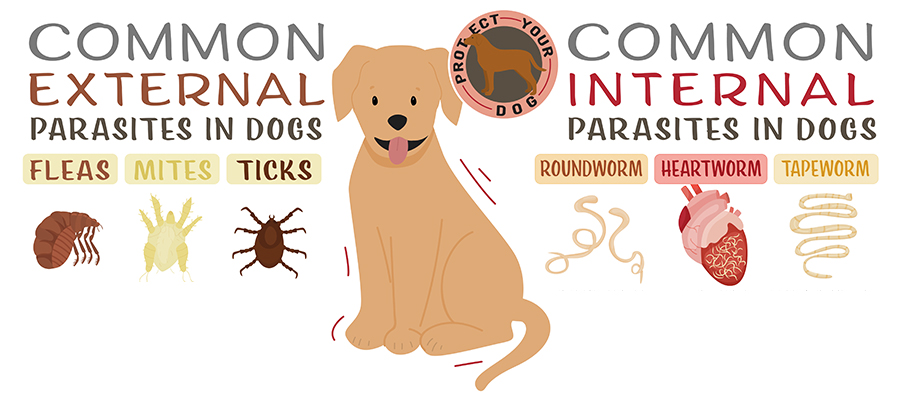
Our clinic is switching from Sentinel Spectrum to Interceptor Plus. So what does that mean for your pups?
To say that it can be confusing when it comes to knowing what preventative products your dog needs is a bit of an understatement. Does your pet really need this stuff? Is it just marketing? Is this a Coke vs Pepsi thing, or are there actual differences in these products?
It can be confusing even for us in the field trying to keep up with all the new options. That’s why we at Medical District Veterinary Clinic have curated a few products we believe in, so you don’t have to do all the research.
Here is what we have and why.
| Product Name | Parasites Covered | Pros | Cons |
| Heartworm/Intestinal Parasites | |||
| Heartgard | Heartworm, hookworms, roundworms, whipworms | + Less expensive + Beef flavored soft chew + More palatable | – Does not cover tapeworms |
| Interceptor Plus | Heartworm, hookworms, roundworms, whipworms, tapeworms | + More expansive coverage of intestinal parasites | – Less economical than Heartgard |
| ProHeart 12 | Heartworm (for 1 year), hookworms, roundworms, whipworms | + One-time injection + About the same price as 12 months of Heartgard | – Hookworm, roundworm, and whipworm preventative only lasts for 1 month |
| Simparica Trio | Heartworm, hookworms, roundworms, whipworms, fleas, ticks | + Product closest to being an “all-in-one” + Less expensive than purchasing Heartgard and NexGard together | – Does not cover tapeworms |
| Fleas/Ticks | |||
| Frontline Gold | Fleas, ticks | + More economical than oral products + Topical (no concern with food sensitivities) | – Less effective against ticks than oral preventatives – Topical (can be messy; need to keep pet away from children for a few hours after application) |
| NexGard | Fleas and ticks | + Works within hours + Soft chew | – More expensive than topicals |
| Simparica Trio | See above | See above | See above |
So which products should you use for your dog? We recommend that all dogs are covered for heartworm, fleas, and ticks year-round, so here are a few combinations to consider:
- Want the simplest way to have your pet covered? Simparica Trio
- Want the most comprehensive coverage? NexGard and Interceptor Plus
- Want to avoid any oral medications? Proheart 12 and Frontline Gold
- Want the most economical year-round coverage? Heartgard and Frontline Gold
So why did we make the decision to transition away from Sentinel Spectrum and move to Interceptor Plus? Mostly to help keep costs down for you. Interceptor Plus is less expensive, and there is just a slight difference in that Interceptor Plus does not have Lufenuron, which stops the development of flea eggs. Lufenuron doesn’t kill adult fleas, so we recommend an additional flea preventative anyway.
If you are dead set on keeping your pup on Sentinel Spectrum, not a problem! We are happy to approve a prescription for you, as long as your pet is a current patient of ours and has an up-to-date heartworm test.
– Dr. Alyssa Kritzman
Illustration from AdobeStock by Double Brain
Heart Murmurs in Dogs and Cats
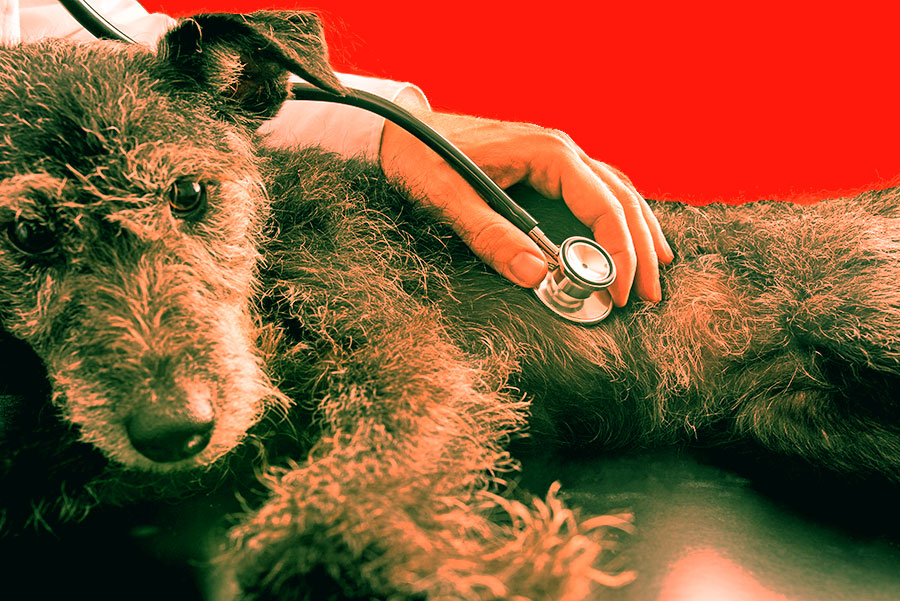
Your veterinarian told you that your pet has a heart murmur, but what does that mean?
A heart murmur is an additional noise heard due to the abnormal flow of blood through the heart’s valves or chambers. This additional noise is then graded on a scale of 1 to 6 based on how loud the heart murmur is. A 1 means the softest and hardest to hear, and a 6 means the loudest.
How loud the heart murmur is does not necessarily correlate to the severity of heart disease. If your pet has a heart murmur, it is not an immediate cause for panic, but rather lets your veterinarian know that more investigation should be done to try and find the cause.
What Causes a Heart Murmur?
There are many causes of heart murmurs. Some heart murmurs are considered “innocent,” also termed “physiologic.” Other heart murmurs are a result of a disease, and these are known as “pathologic.” Pathologic heart murmurs can be caused by a structural problem with the heart or can be caused by disease not related to the heart itself, called functional heart murmurs.
Innocent Heart Murmurs
An innocent heart murmur means there is no heart disease that explains the presence of the heart murmur. In dogs, these murmurs occur most often in puppies. They can occur in cats of any age.
These murmurs are usually very soft. In puppies and kittens, these murmurs usually appear around 6 to 8 weeks of age and should go away on their own by the age of 4 to 5 months. In adult cats, stress may cause an innocent heart murmur.
Structural Heart Disease
An abnormal defect or structure that disrupts the normal flow of blood leads to structural heart disease. Examples of these include valve disease that causes the valves between the chambers of the heart to not close or open properly, a hole in the heart that causes two chambers or two arteries to be connected when they shouldn’t be, and narrowing or widening of the blood vessels.
Functional Heart Murmurs
Heart murmurs can also be caused by disease outside of the heart, or extra-cardiac disease. There are many causes of functional heart murmurs, including anemia (low levels of red blood cells), fever, pregnancy, infection, obesity, being significantly underweight, and hypoproteinemia (low protein levels in the blood).
Signs, Diagnostics, and Treatment
In some cases, your pet may not be experiencing any signs of having a heart murmur. In others, you may have noticed signs of poor appetite, exercise intolerance, trouble breathing or fast breathing when resting or sleeping, collapse or fainting, weight loss, coughing, pale gums, and weakness.
If your pet is found to have a heart murmur, your veterinarian will discuss additional testing that may be beneficial in finding the cause of the heart murmur and to determine the severity of the condition causing the murmur. Diagnostics that may be suggested include bloodwork, chest X-rays, and blood pressure testing.
Your veterinarian will likely suggest referral to a veterinary cardiologist or an imaging center for an echocardiogram. An echocardiogram is an ultrasound of the heart to get an idea of what the heart looks like and how it is functioning in real time. More specifically, an echocardiogram will provide information about the shape, size, and function of the heart’s four chambers, valves, and other surrounding structures.
Together, these diagnostics will provide your pet’s veterinarian with the information needed to determine what treatment and medication, if needed, will be necessary to help your pet live a longer, happy life.
By Dr. Jeanette Barragan
Illustration from photo by Gajus
La Importancia de la Diversidad en la Medicina Veterinaria

En honor al Mes de La Historia Afroamericana, profundizaremos en por qué la diversidad es importante en la medicina veterinaria.
La diversidad en la medicina veterinaria no es solo un imperativo moral; es una necesidad para el avance del campo y la provisión de atención equitativa a todos los animales. Sin embargo, a pesar del reconocimiento creciente de su importancia, persisten disparidades en la representación de grupos minoritarios dentro de los programas veterinarios.
Mejor Acceso a la Atención
Las comunidades minoritarias a menudo enfrentan barreras para acceder a la atención veterinaria, incluyendo factores socioeconómicos, lenguaje, diferencias culturales y ubicación geográfica. Con solo 1.3% de veterinarios afroamericanos/negros y 7.9% hispanos/latines reportados en 2023, al aumentar la diversidad dentro de la profesión veterinaria, podemos comprender y abordar mejor las necesidades únicas de estas comunidades, asegurando que todos los animales reciban la atención que merecen.
Innovación y Resolución de Problemas
Los equipos diversos son más hábiles para resolver problemas e innovar debido a la variedad de perspectivas y enfoques que aportan. En la medicina veterinaria, esta diversidad de pensamiento puede llevar a soluciones creativas para desafíos complejos, desde la prevención de enfermedades hasta las metodologías de tratamiento.
Representación y Modelos a Seguir
Aumentar la diversidad dentro de los programas veterinarios, sean doctores, enfermeros, asistentes, o personal de recepción, presenta una oportunidad para los grupos subrepresentados modelos a seguir y mentores a quienes pueden relacionarse e inspirarse para emular. Esta representación es esencial para inspirar a las futuras generaciones de profesionales veterinarios diversos y derribar barreras de entrada al campo.
Estadísticas sobre las Tasas de Aceptación para Minorías
Aunque ha habido avances en el aumento de la diversidad dentro de los programas veterinarios, persisten disparidades en las tasas de aceptación para estudiantes de minorías. Según datos recientes:
- Los estudiantes afroamericanos/negros constituyen solo un pequeño porcentaje de los solicitantes y matriculados en escuelas de veterinaria, con tasas de aceptación significativamente más bajas que las de sus contrapartes blancos.
- Los estudiantes hispanos/latines también están subrepresentados en los programas veterinarios, enfrentando barreras como acceso limitado a recursos educativos y limitaciones financieras.
- Los estudiantes indígenas/nativos americanos están entre los grupos más subrepresentados en la medicina veterinaria, con tasas de aceptación muy por debajo del promedio nacional.
A pesar de los esfuerzos para promover la diversidad y la inclusión dentro de la educación veterinaria, estas estadísticas resaltan la necesidad de defensa y acción continuas para abordar barreras sistémicas y aumentar el acceso a programas veterinarios para estudiantes de minorías.
Conclusión
La diversidad no es solo una palabra de moda; es un aspecto fundamental de la medicina veterinaria que enriquece la profesión y mejora la calidad de la atención proporcionada a los animales. Con 25% de grupos subrepresentados componiendo la clase de 2025 en el Colegio de Medicina Veterinaria en la Universidad de Illinois, seguiremos los esfuerzos para aumentar la representación y abordar las disparidades en las tasas de aceptación para minorías. Podemos construir una fuerza laboral veterinaria más inclusiva que refleje la diversidad de las comunidades a las que servimos. Es hora de reconocer la importancia de la diversidad en la medicina veterinaria y tomar medidas significativas hacia la creación de una profesión más equitativa e inclusiva.
—Dr. Ana Valbuena
The Importance of Diversity in Veterinary Medicine

Diversity in veterinary medicine is not just a moral imperative; it’s a necessity for advancing the field and providing equitable care to all animals. However, despite the growing recognition of its importance, disparities persist in the representation of minority groups within veterinary programs.
In honor of Black History Month, we will delve into why diversity is important in veterinary medicine.
Better Access to Care
Minority communities often face barriers to accessing veterinary care, including socioeconomic factors, language barriers, cultural differences, and geographical location. According to the Bureau of Labor Statistics, among all U.S. veterinarians in 2023 only 1.3% are African American/Black veterinarians and 7.9% are Hispanic/Latinx veterinarians. Increasing diversity within the veterinary profession allows us to better understand and address the unique needs of these communities, ensuring that all animals receive the care they deserve.
Innovation and Problem Solving
Diverse teams are more adept at problem-solving and innovation due to the variety of perspectives and approaches they bring. In veterinary medicine, this diversity of thought can lead to creative solutions for complex challenges, from disease prevention to treatment methodologies.
Representation and Role Models
Increasing diversity within veterinary programs, whether doctors, nurses, assistants, or reception staff, provides an opportunity for underrepresented groups to find role models and mentors they can relate to and aspire to emulate. This representation is essential for inspiring future generations of diverse veterinary professionals and breaking down barriers to entry into the field.
Statistics on Acceptance Rates for Minorities
Although there have been advances in increasing diversity within veterinary programs, disparities persist in acceptance rates for minority students. According to recent data:
- African American/Black students make up only a small percentage of applicants and enrollees in veterinary schools, with significantly lower acceptance rates than their white counterparts.
- Hispanic/Latinx students are also underrepresented in veterinary programs, facing barriers such as limited access to educational resources and financial constraints.
- Indigenous/Native American students are among the most underrepresented groups in veterinary medicine, with acceptance rates far below the national average.
Despite efforts to promote diversity and inclusion within veterinary education, these statistics highlight the need for continued advocacy and action to address systemic barriers and increase access to veterinary programs for minority students.
Conclusion
Diversity is not just a trend; it’s a fundamental aspect of veterinary medicine that enriches the profession and improves the quality of care provided to animals. For the past four years, the incoming class of students at the College of Veterinary Medicine at the University of Illinois has been made up of one-quarter students from underrepresented groups. We will continue efforts to increase representation and address disparities in acceptance rates for minorities. We can build a more inclusive veterinary workforce that reflects the diversity of the communities we serve. It’s time to recognize the importance of diversity in veterinary medicine and take meaningful steps toward creating a more equitable and inclusive profession.
—Dr. Ana Valbuena
New Year’s Resolution: No Overweight Pets

With the start of the new year, you might have noticed an increase in the number of gym memberships and more people waiting in line to use the elliptical. If you’ve also noticed that your pet at home has packed on a couple of extra holiday pounds, now would be a perfect time to start considering some weight loss for your pet. Increased weight can lead to obesity, and various negative health conditions can follow.
How Do I Know If My Pet Is Overweight?
Pets are given a body condition score (BCS) to determine if they are overweight, underweight, or at an ideal body weight. BCS is determined not only by the number on the scale and physical appearance, but also fat deposits felt by your veterinarian during the exam along with amount of muscle mass. Below are charts from the Association for Pet Obesity Prevention that illustrate body condition scores for dogs and cats. Please reach out to your local veterinarian if you would like to know if your pet is overweight.
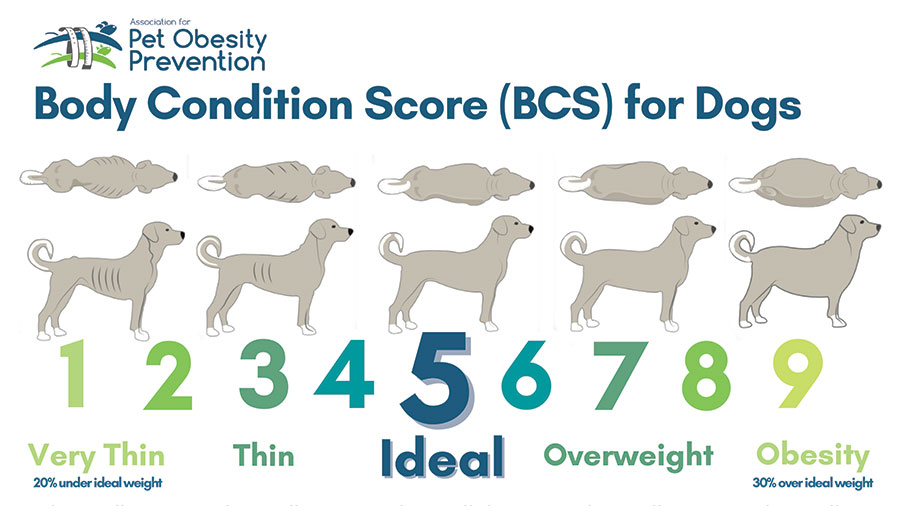
- Ribs visible from a distance under shorthair, no palpable body fat
- Ribs visible under shorthair, no palpable fat
- Ribs may be visible under shorthair, no palpable fat
- Ribs minimally visible, easy to palpate with minimal fat cover
- Ribs not visible, easy to palpate with minimal fat covering
- Ribs palpable under mild fat covering
- Ribs palpable with difficulty under moderate fat covering. Mild fat deposits over lumbar area and tail base
- Ribs palpable only with significant pressure under marked fat deposits. Moderate fat deposits over lumbar area and tail base
- Ribs not palpable under marked fat deposits. Marked fat deposit over spine including the neck and tail base
What Are the Health Risks?
Obesity is associated with many negative health conditions. Such conditions include joint disease and osteoarthritis, heart disease, respiratory distress, decreased grooming in cats, diabetes mellitus, increased anesthetic risk, and ultimately a decreased lifespan.
Joint Disease and Osteoarthritis: Extra weight adds extra pressure and stress on joints, which can lead to early joint degeneration and decreased mobility. This, in turn, can exacerbate obesity. In a patient undergoing a weight loss journey, adding joint supplements can help strengthen joints, which may increase mobility and comfort, ultimately helping with weight loss.
Diabetes Mellitus: Extra body fat can lead to insulin resistance. Weight loss can help decrease a cat’s risk for the development of diabetes mellitus. According to a study at Cornell University College of Veterinary Medicine, obese cats are four times more likely to develop diabetes than are cats with an ideal BCS.
Heart Disease: Although fat is relatively nonvascular tissue, it still requires blood flow, which leads to an increase in circulatory volume and cardiac output, ultimately resulting in hypertension. Compared to dogs with an ideal body weight, obese dogs develop negative changes to the overall structure and function of their heart.
Why Do Pets Become Overweight?
Well, we are the culprits. Overfeeding, lack of exercise, and too many treats can lead to obesity in pets. Various endocrine diseases are associated with obesity, such as Cushing’s disease and hypOthyroidism in dogs. In cats, weight loss and low BCS are commonly associated with hypERthyroidism.
What Do I Do If My Pet Is Overweight?
Weight loss can be a hard, slow process. It takes much time and patience. When your veterinary team works with you and provides the right tools, we can achieve a healthy weight for your pet.
There are many dietary changes that can be done in order to achieve weight loss in your pet. A great start is checking out the Pet Nutrition Alliance website. When you enter your dog’s current weight and body condition score, this website calculates a calorie count for you. It is important to account for all food AND treats using this calorie count. Please reach out to your local veterinarian if you would like to know your pets BCS.
There are several over-the-counter options as well as prescription diets that can be given to your pet for weight loss. When feeding in cups, it is important to use an actual measuring cup to avoid overfeeding/underfeeding. Calories per cup can vary, so please check the back of the bag for an accurate calorie measurement of how many cups your pet should be eating. Healthy, low-calorie fruits and vegetables such as apple slices, carrots, celery, and cucumber can be used as treats. Please avoid grapes, raisins, onion, garlic, and avocados, which can be highly toxic to pets.
Exercise is a very important component in order to achieve weight loss. Therefore, adding more play time, frequent walks, and possibly even a kitty treadmill can help achieve your pet’s weight loss goals. Frequent weigh-ins are also a very important component for weight loss to track the progression of your pet’s weight.
If you suspect that your pet is overweight, please reach out to your primary care veterinarian to you can discuss the best option for your pet.
From ‘Fat Vincent’ to ‘Skinny Vinny’
In 2016, a 7-year-old obese dachshund named Vincent was surrendered to an animal shelter in Houston, Texas, after his owner died. He weighed 38 pounds. Thanks to the help of K-9 Angels Rescue, he was able to lose over half of his body weight and was renamed Skinny Vinny. He weighed in at 17 pounds after an 8-month weight-loss journey.
By Dr. Angélica Calderón
Dog image: VinnieRattolle, CC BY-SA 4.0, via Wikimedia Commons
Propósitos de Año Nuevo para todos
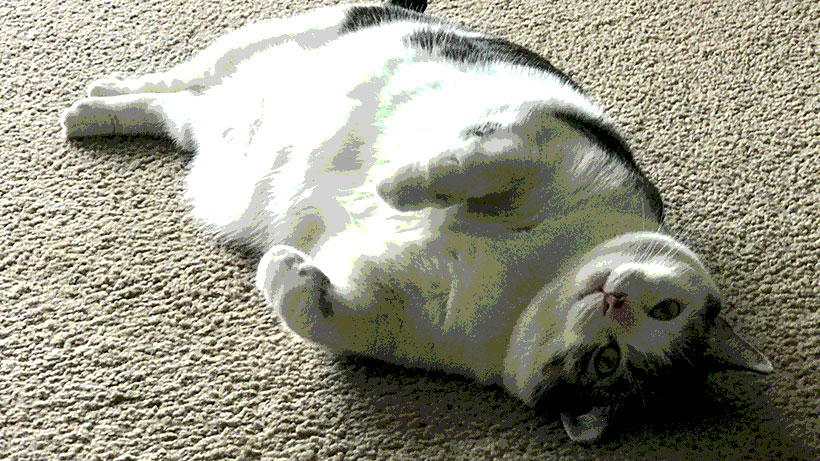
Con el comienzo del nuevo año, es posible que hayas notado un aumento en el número de membresías en gimnasios y más personas esperando en fila para usar la máquina elíptica. Ahora, si ha notado que su mascota en casa subio un par de kilos de más durante las vacaciones, entonces sería un momento perfecto para comenzar a considerar perder algo de peso; ya que el aumento de peso puede provocar obesidad y pueden producirse diversas condiciones negativas de salud.
¿Cómo puedo saber si mi mascota tiene sobrepeso?
A las mascotas se les asigna una puntuación de condición corporal (también conocida como BCS) para determinar si tienen sobrepeso, bajo peso o si tienen un peso corporal ideal. Comuníquese con su veterinario local si desea saber si su mascota tiene sobrepeso.
A continuación se muestran gráficos de la Asociación para la Prevención de la Obesidad de las Mascotas que ilustran las puntuaciones de condición corporal de perros y gatos. Comuníquese con su veterinario local si desea saber si su mascota tiene sobrepeso.
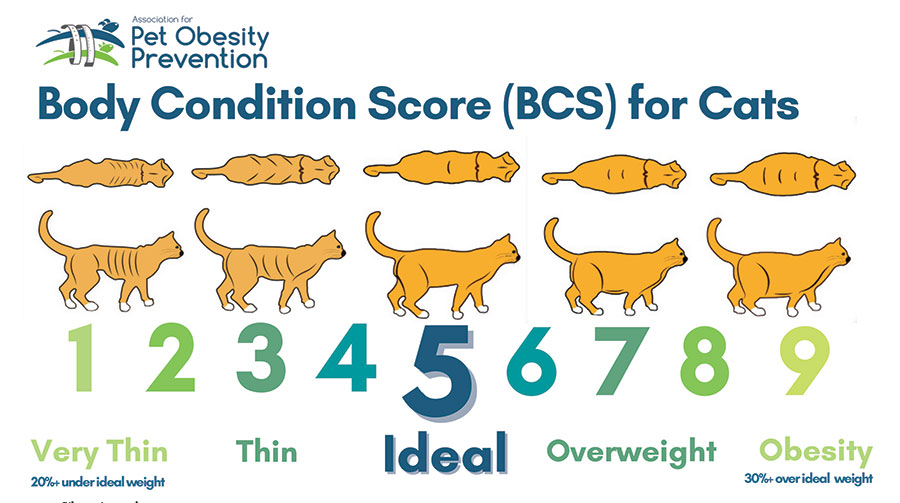
- Costillas visibles desde lejos debajo del pelo corto, sin grasa corporal palpable
- Costillas visibles debajo del pelo corto, sin grasa palpable
- Las costillas pueden ser visibles debajo del pelo corto, no se palpa grasa
- Costillas mínimamente visibles, fáciles de palpar con mínima cobertura de grasa
- Costillas no visibles, fáciles de palpar con una cobertura mínima de grasa
- Costillas palpables bajo una leve capa de grasa
- Costillas palpables con dificultad bajo una cubierta grasa moderada. Depósitos leves de grasa sobre la zona lumbar y la base de la cola.
- Costillas palpables sólo con una presión significativa bajo depósitos de grasa marcados. Depósitos moderados de grasa sobre la zona lumbar y la base de la cola.
- Costillas no palpables bajo depósitos de grasa marcados. Depósito de grasa marcado sobre la columna, incluido el cuello y la base de la cola.
¿Cuales son los riesgos para la salud?
La obesidad está asociada con muchas condiciones de salud negativas. Dichas afecciones incluyen enfermedades como osteoartritis, enfermedades cardíacas, dificultad respiratoria, disminución del aseo en los gatos, diabetes mellitus, mayor riesgo anestésico, y en casos graves menos tiempo de vida.
Enfermedades de osteoartritis: El peso extra añade presión y estrés adicionales a las articulaciones, lo que puede provocar una degeneración temprana de los huesos y una disminución de la movilidad, lo que a su vez puede exacerbar la obesidad. En un paciente que está pasando por un proceso de pérdida de peso, agregar suplementos para los huesos puede ayudar a fortalecer los huesos, lo que puede conducir a una mayor movilidad y mayor comodidad.
Diabetes mellitus: El exceso de grasa corporal puede provocar resistencia a la insulina y la pérdida de peso puede ayudar a disminuir el riesgo de que un gato desarrolle diabetes mellitus. Según un estudio de la Facultad de Medicina Veterinaria de la Universidad de Cornell, los gatos obesos tienen cuatro veces más probabilidades de desarrollar diabetes que un gato con un BCS ideal.
Enfermedad cardíaca: Aunque la grasa es un tejido relativamente no vascular, aún requiere perfusión, lo que conduce a un aumento en el volumen circulatorio y el gasto cardíaco, lo que puede resultar en hipertensión. En comparación con los perros con un peso ideal, los perros obesos tienen varios cambios en la estructura y función general de su corazón.
¿Por qué las mascotas tienen sobrepeso?
Bueno, nosotros somos los culpables. La sobrealimentación, la falta de ejercicio y demasiados premios pueden provocar obesidad en las mascotas. Varias enfermedades endocrinas están asociadas con la obesidad, como la enfermedad de Cushing y el hipotiroidismo en perros, mientras que la pérdida de peso y un nivel bajo de BCS pueden estar asociados con el hipertiroidismo en los gatos.
¿Qué hago si mi mascota tiene sobrepeso?
La pérdida de peso puede ser un proceso lento y difícil y requiere mucho tiempo y paciencia. Somos un equipo pero con las herramientas adecuadas podemos lograr un peso saludable para tu mascota.
Hay muchos cambios en la dieta que se pueden realizar para lograr la pérdida de peso de su mascota. Un buen comienzo es visitar el sitio web de Pet Nutrition Alliance. Este sitio web le permite ingresar el peso actual de su perro junto con su puntuación de condiciones corporales. Se calcula un recuento de calorías. Es importante tener en cuenta todos los alimentos y premios utilizando este recuento de calorías.
Hay varias opciones de venta libre, así como dietas recetadas que se pueden administrar a su mascota para bajar de peso. Varias marcas de alimentos de venta libre tienen una fórmula “baja en calorías” o de “peso perfecto”. Al alimentar en tazas, es importante utilizar una taza medidora para evitar la sobrealimentación o la subalimentación. Las calorías por taza varían, así que revise la parte posterior de la bolsa de comida para obtener una medida precisa de cuánto debe comer su mascota. Se pueden utilizar frutas y verduras saludables bajas en calorías como premio. Varias opciones incluyen rodajas de manzana, zanahorias, apio y pepino. Evite las uvas, las pasas, la cebolla, el ajo y los aguacates, ya que pueden ser muy tóxicos.
El ejercicio es un componente muy importante para lograr la pérdida de peso. Por lo tanto, agregar más tiempo de juego, caminatas frecuentes y posiblemente incluso una cinta de correr para gatos puede ayudar a lograr los objetivos de pérdida de peso de su mascota. Los pesajes frecuentes también son un componente muy importante para la pérdida de peso para realizar un seguimiento de la progresión del peso de su mascota.
Si sospecha que su mascota tiene sobrepeso, comuníquese con su veterinario para que pueda analizar la mejor opción para su mascota.
De ‘Fat Vincent’ a ‘Skinny Vinny’
En 2016, un perro salchicha obeso de 7 años llamado Vincent fue entregado a un refugio de animales en Houston, Texas, después del fallecimiento de su dueño. Pesaba 38 libras. Gracias a la ayuda de K-9 Angels Rescue, pudo perder más de la mitad de su peso corporal y pasó a llamarse Skinny Vinny. Pesó 17 libras después de un viaje de pérdida de peso de 8 meses.
By Dr. Angélica Calderón
Cat image: Jami430, CC BY-SA 4.0, via Wikimedia Commons
Mystery Canine Respiratory Illness
Fear of the Unknown, or Fear of Saying ‘I Don’t Know’?

Originally, I was planning to write this blog about the current “mystery illness” that is popping up in random places around the United States. But when I sat down to research what I could, I kept getting stuck on the word “unknown.” It made me think about all that I haven’t figured out myself yet.
“I don’t know” is a phrase that you are likely to hear from me as your pet’s veterinarian. It is a phrase that I used to be terrified of saying when I first started practicing medicine over a decade ago.
I spent a lot of time (most of my 20s) and money (over six figures) learning everything about biology, chemistry, pharmacology, virology, physiology, anatomy (of multiple species, mind you!), really any animal-related “-ology” so I could avoid that very phrase.
Why I Say ‘I Don’t Know’
Now, with years of experience in the field, I frequently say “I don’t know” because I am so acutely aware that figuring out why an animal is sick (we call this a differential diagnosis) is often much harder than just making an animal feel better (we call this empiric therapy).
There are a few reasons why this is so:
- Answers often cost money. Even the best veterinarians can go only so far on a physical exam and asking good questions. Eventually we need test results, but this costs money—your money—and sometimes we don’t need an answer to find the treatment. We want to put your resources to the best use. If we use up the available budget to find answers, that may mean we have fewer resources to provide the care your pet needs.
- Answers often aren’t easy. One of the worst things that has ever happened to any medical professional is the show CSI. They always find the answer in a convenient hour (or 40 minutes if you’re paying for premium streaming). This is just not reality. Yes, sometimes tests to give you a precise answer, but a lot of times testing provides information and clues. Then I use my expensive degree to put all the pieces of the puzzle together.
- Answers often aren’t universal. This is what I mean when I say a pet “hasn’t read the textbook.” The same problem does not always manifest in the same way in every pet. (Not to put all the blame on cats, but it’s usually cats who haven’t read the textbook!) That can mean that even if we think we know what’s going on, we can get curveballs.
I know this may not instill a lot of confidence in what I and my colleagues do, but I say this because I want you to know that getting an answer isn’t my only goal. I want to help you and your pet in the best way possible. Often these goals are at odds with each other.
We Still Don’t Have an Answer
This brings me to the current “crisis” going on in veterinary medicine right now: the mystery respiratory illness that is affecting dogs. We still don’t have an answer as to what it is. It won’t be easy or cheap to figure out, but there are people working on it. As soon as we have verified information, we will let you know.
For now, we’re left with the general guidance of trying to keep your dog away from crowded canine events as much as possible (I will be boarding my own dog over the Christmas because that’s our only option), keeping them away from unhealthy dogs, and keeping up with the recommended respiratory vaccines like distemper, bordetella, and parainfluenza, and, for some dogs, influenza.
It’s hard accepting “we don’t know,” but to tell you anything more than that would be foolish. In all my years of practice, I would much rather say “I don’t know” than “I was wrong.”
—Dr. Alyssa Kritzman
Diabetes in Cats: Prevention and Treatment
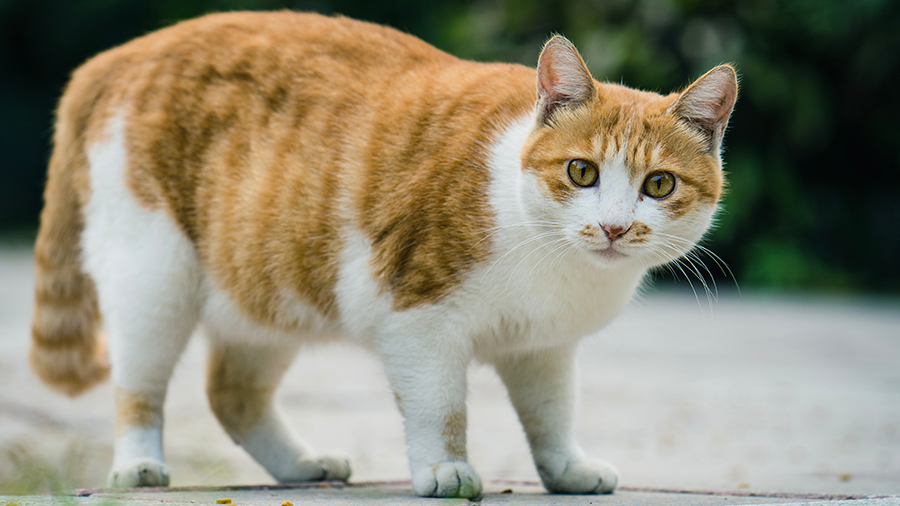
Diabetes mellitus is a condition in which the body cannot properly produce or respond to the hormone insulin. Insulin regulates the amount of glucose (sugar) in the bloodstream and delivers glucose to the tissues of the body to use as energy. Diabetes results in elevated levels of glucose in the blood. The most common form of diabetes in cats is type 2 diabetes. In type 2 diabetes, glucose levels are high because cells in the body do not respond appropriately to insulin.
Diabetes is the second most common endocrine disease in cats. (The body’s endocrine system consists of several glands—in the case of diabetes, that gland is the pancreas—that make hormones, which are chemical messengers to control organs throughout the body.)
Cats are typically diagnosed with diabetes between the ages of 10 and 13 years. More cats are acquiring diabetes as the number of overweight or obese cats grows. The average cat that weighs 13 pounds or more has about four times the risk of developing diabetes as a smaller cat. Signs of diabetes can include increased thirst, increased urination, weight loss, and increased appetite.
Diagnosis
When a cat is suspected of having diabetes, a veterinarian will perform blood and urine testing. Diabetes is indicated if blood testing shows an elevated glucose level (hyperglycemia) and urine testing shows evidence of glucose in the urine (glucosuria).
Because stress in cats can lead to both hyperglycemia and glucosuria, another confirmation test called fructosamine is usually done. Fructosamine concentration reflects the average glucose concentration for the past 1 to 2 weeks and is not impacted by stress. If this test comes back as elevated, the diagnosis of diabetes is confirmed.
Treatment
Insulin is the treatment of choice for cats with diabetes. This typically requires twice daily administration. In addition, dietary management can be an important component of managing diabetes in cats. A high-protein/low-carbohydrate diet is recommended. Weight loss is also an important component of diabetic management in overweight cats. Weight loss, if attempted, should ideally be gradual, one-half percent to 1% of total body weight lost per week.
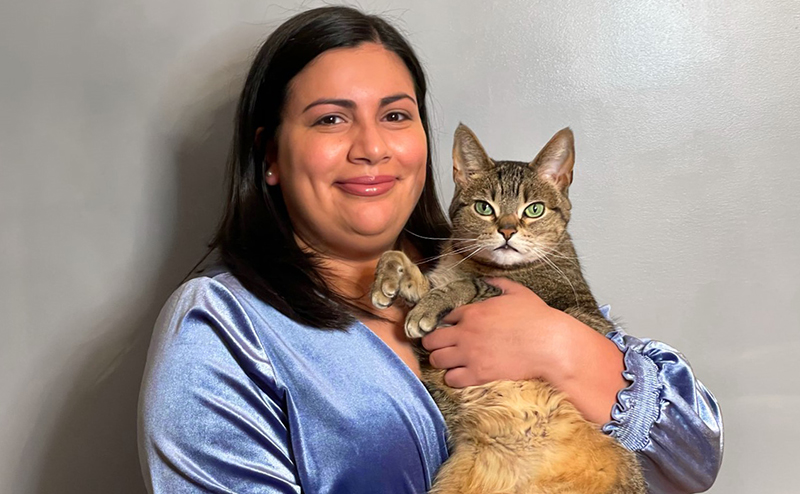
The goals of treatment are to maintain a healthy blood glucose, stop or control unintended weight loss, stop or control increased thirst and urination, and avoid hypoglycemia (low blood glucose).
Unlike dogs, cats can reach diabetic remission; these cats have near-normal blood glucose levels without receiving insulin or other blood-sugar–lowering medication. However, cats in diabetic remission require close monitoring to ensure that they do not relapse. Remission is not achievable in every diabetic cat.
Monitoring
Blood glucose curves are used to monitor response to insulin dosing. If a blood glucose curve is performed at home, pet owners measure the first blood glucose reading before the insulin injection. Then, they test every 2 to 4 hours until the next dose of insulin, depending on the type of insulin used. Performing curves at home eliminates the stress of coming to the clinic, which can affect the accuracy of the testing. Owners may need to perform a blood glucose curve several times to find the right dose for their cat.
One method of measuring glucose is by using a glucose meter calibrated for feline blood, such as a AlphaTRAK3. Another way is by using a continuous glucose monitor, such as a FreeStyle Libre. These monitors can be picked up at a human pharmacy and installed by a veterinarian or veterinary technician. Other important monitoring tests include serial bloodwork and urine testing. Your veterinarian will help determine the frequency at which these tests should be performed.
Monitoring your cat’s level of thirst and urination, weight, and appetite are important throughout treatment. These measures can give clues as to how well the diabetes is being managed. Unfortunately, monitoring response to treatment in diabetic cats can be frequent and expensive.
Complications of Diabetes
One complication of diabetes is diabetic ketoacidosis (DKA). This problem occurs when there is not enough insulin in the body to control the amount of glucose in the blood. DKA happens in uncontrolled diabetics. Without the proper amount of insulin in the body, glucose cannot be used as an energy source. Instead, the body breaks down fat, which produces ketone bodies. With high levels of ketones, the body becomes more acidic, which disrupts fluid and electrolyte balance. Left untreated, the resulting abnormal electrolyte balance may lead to abnormal heart rhythms and muscle function and death. Signs of DKA can include increased thirst or urination, lethargy, weakness, vomiting, increased respiratory rate, decreased appetite, and weight loss.
The other complication is hypoglycemia, or low blood sugar, which may arise when insulin therapy lowers the blood sugar significantly. Signs of hypoglycemia include weakness, lethargy, vomiting, lack of coordination, seizures, and coma. Hypoglycemia can be fatal if left untreated. A diabetic cat that shows any of these signs should be offered its regular food immediately. If the cat does not eat voluntarily, it should be given oral glucose in the form of honey, corn syrup, or dextrose gels and brought to a veterinarian immediately. However, if a cat is seizing or comatose, oral glucose methods should not be attempted.
If you’ve noticed changes to your cat’s eating and drinking habits as well as weight, please have them seen by a veterinarian for additional testing to be done as soon as possible.
By Jeanette Barragan, DVM
¿Qué hacer cuando su gato(a) hace del baño afuera de su caja?

Photo by Luku Muffin on Unsplash
¡Orinar o defecar fuera de la caja de arena puede ser muy frustrante para todos! También puede ser la primera, y a veces la única, señal de que algo anda mal. Se recomienda encarecidamente una visita al veterinario cada vez que haya un comportamiento inusual en nuestras mascotas, particularmente la micción inapropiada. Mientras tanto, considere lo siguiente:
Todos los gatos necesitan satisfacer sus necesidades básicas. Sin embargo, cuando hay varios gatos en el hogar, es particularmente importante asegurarse de que haya muchos recursos en forma de cajas de arena, estaciones de alimentación, espacios verticales, estaciones para dormir, escondites y tazones de agua. El castigo es ineficaz y confuso para los gatos. El entrenamiento basado en recompensas ayuda a mejorar la comunicación al tiempo que proporciona estimulación mental e interacción humana positiva. Los juguetes dispensadores de alimentos y rompecabezas imitan la caza y fomentan la exploración de su ambiente, reduciendo los niveles generales de estrés y satisfaciendo las necesidades básicas.
Los modelos generales que le ayudarán a satisfacer las necesidades básicas de la caja de arena incluyen las siguientes sugerencias:
- Tenga una caja de arena más que gatos para que los gatos más quisquillosos puedan encontrar una caja limpia. ¡La regla es 1 caja de arena por gato más una extra!
- La ubicación importa: los gatos prefieren un área tranquila y aislada, lejos de electrodomésticos ruidosos, hornos, aire acondicionado y áreas de tráfico pesado.
Considere el uso de feromonas como Feliway para reducir el estrés si ha tenido cambios recientes dentro del hogar (nuevo bebé o mascota, mudanza, visitas, etc.) - El tamaño importa: las cajas de arena deben ser al menos 1.5 veces la longitud del cuerpo del gato y aproximadamente 3 veces más anchas que el gato.
¡Considera crear una nueva caja de arena a partir de un contenedor de almacenamiento si no puedes encontrar una lo suficientemente grande! Las cajas de suéteres debajo de la cama son excelentes cajas de arena.(YouTube tiene muchos videos geniales DIY)
El aumento de peso y la obesidad es un gran problema para nuestros amigos felinos. Además de dificultar encontrar una caja lo suficientemente grande, el exceso de grasa afecta negativamente a la salud y la longevidad de un gato. Tienen un mayor riesgo de cáncer, diabetes y problemas cardíacos. También son propensos a la artritis y a una degeneración más rápida de las articulaciones afectadas: ¡puede doler saltar a la caja o adoptar la postura para ir al baño! - Saca la caja varias veces al día.
- Incluso con arenas aglomeradas, deseche la caja al menos una o dos veces por semana.
- Lave la caja semanalmente, enjuague bien y seque al aire para eliminar cualquier olor del agente de limpieza. El agua caliente y el jabón son los mejores para la limpieza.
- No use arena perfumada, revestimientos o aditivos como bicarbonato de sodio.
- Si al gato le gusta cavar, haz que la arena sea profunda. Si el gato sacude la arena de sus patas, haz que la arena sea poco profunda o cambia a un tipo diferente (aserrín granulado, trigo sarraceno, etc.).
- Lavar, enjuagar y secar cualquier área que el gato haya ensuciado fuera de la caja y luego use un buen removedor de olores. Los mejores ayudan a descomponer enzimáticamente los compuestos de la orina y hacen que algunos odorantes sean demasiado pesados para ser inhalados. NO use lejía ni productos pesados similares.
- De todos modos, siga al gato y vea lo que elige, imite esa elección.
Are You Finding Pee or Poop Outside the Litter Box?
Urinating or defecating outside the litter box can be very frustrating for all! It can also be the very first, and sometimes only, sign that something is wrong. A veterinary visit is highly encouraged any time there is unusual behavior in our pets, particularly inappropriate urination.

In the meantime, consider the following:
All cats need their basic needs met. However, when there are multiple cats in the household, it is particularly important to make sure there are plenty of resources in the form of litter boxes, feeding stations, vertical spaces, sleeping stations, hiding areas, and water bowls. Punishment is ineffective and confusing for cats. Reward-based training helps to improve communication while providing mental stimulation and positive human interaction. Food dispensing and puzzle toys mimic hunting and encourage exploration of their environment, reducing overall stress levels and meeting basic needs.
General guidelines that will help you meet the basic litter box needs include the following suggestions.
- Have one more litter box than you have cats so that fussier cats can find a clean box. The rule is 1 litter box per cat plus an extra!
- Location matters: cats prefer a quiet, secluded area away from loud appliances, furnaces, air conditioning, and heavy traffic areas.
Consider using pheromones like Feliway for stress reduction if you have had recent changes within the household (new baby or pet, moving, visits, etc.) - Size matters: litter boxes should be at least 1.5 times the length of the cat’s body and about 3 times as wide as the cat so the cat can move and turn around.
Consider creating a new litter box out of a storage bin if you cannot find one big enough! Underbed sweater boxes make great litter boxes. (YouTube has many great DIY videos.)
Weight gain and obesity is a huge problem for our feline friends. Apart from making it difficult to find a box that is big enough, excess fat negatively impacts a cat’s health and longevity. Heavy cats are at a higher risk for cancer, diabetes, and heart issues. They are also prone to arthritis and faster degeneration of the affected joints. It may hurt to jump into the box or posture to potty! - Scoop the box multiple times a day.
- Even with clumpable litters, dump the box at least once or twice a week.
- Wash the box weekly, rinse well, and air dry to remove any odor of the cleaning agent. Hot water and soap are best for cleaning.
- Do not use scented litter, liners, or additives like baking soda.
- If the cat likes to dig, make the litter deep. If the cat flicks the litter from his or her feet, make the litter shallow or switch to a different type (pelleted sawdust, buckwheat, etc.).
- Wash, rinse, and dry any area the cat has soiled outside the box and then use a good odor eliminator. The best ones help to enzymatically break down urine compounds and make some odorants too heavy to be sniffed. Do NOT use bleach or similar heavy products.
- Regardless, follow the cat around and see what that cat chooses – mimic that choice.
—Dr. Ana Valbuena
What’s Urgent and What’s an Emergency?
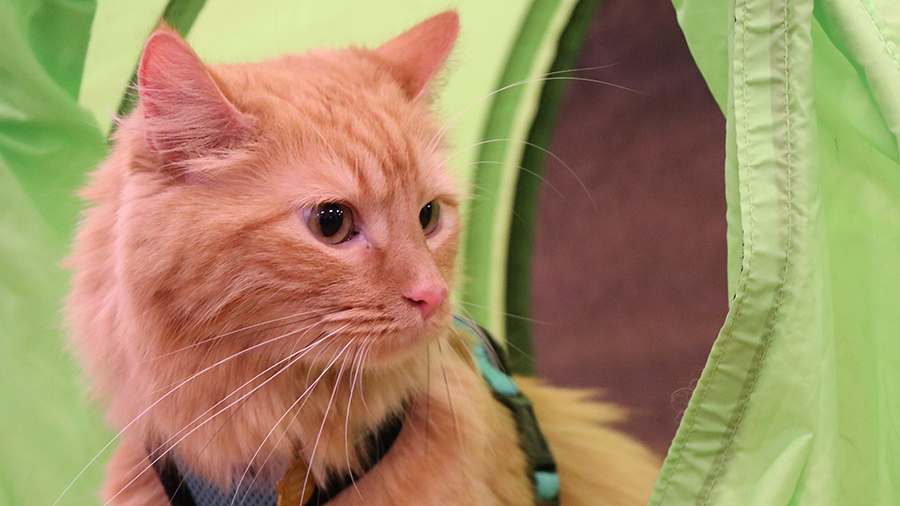
Do any of the following sound familiar? Or have you ever contemplated what you would do if your pet became ill or injured when your primary care clinic is unavailable?
- Winnie cut her paw at the dog park. It is not a large cut but looks pretty deep and is bleeding quite a bit. Medical District Vet Clinic is closed or, unfortunately, fully booked. What do I do?
- Tiger has not been eating for the past three days. Now it’s Friday night and I am off work and would like her examined as I am getting worried. Where should I take her?
- Bowie has not urinated in over 8 hours. He is in and out of the litter box, trying to pee. Where should I go?
I am sure many of you have had similar questions and or situations. Fortunately, multiple options exist for care when you can’t bring your pet to a primary care clinic. To help our clients, we have created handouts listing options for emergency clinics and specialty hospitals in Chicago.
In this blog, I want to help explain the difference between the urgent care and emergency clinics here in the Chicago area and when I would recommend going where.
After-Hours Care Options
Urgent care facilities would typically not be set up to perform surgery or hospitalize overnight but could handle most cases of pet illness. Most cases can be treated as outpatient. If not, urgent care facilities may recommend transfer to a specialty emergency clinic.
Non-specialty emergency clinics are typically open 24 hours and have varied capabilities when it comes to both diagnostics and doctor capabilities. They can handle most emergencies, but do not have the luxury of referring to or consulting with a specialist on staff. In severe cases, they may recommend referral. If your pet is very ill, I suggest that you ask them about referral to a specialty hospital.
Specialty/emergency hospitals will have the capability of performing the most advanced diagnostics and have the benefit of specialty referral when needed. These hospitals have board-certified veterinary specialists, who have 4 to 6 years of specialty training beyond veterinary school.
Think about human medicine and all the specialties. Veterinary medicine is not quite as specialized. Still, our specialties include ophthalmology, surgery, oncology, internal medicine, dermatology, dentistry, radiology, emergency and critical care, and more. These doctors often work with the most complicated, severe cases of illness and disease and manage the cases while hospitalized.
What’s the Cost?
How much do these hospitals cost? I am sure many of you are contemplating this question.
First, I want to point out that Medical District Vet Clinic is not associated with any urgent care or specialty hospitals in Chicago. For this reason, I have limited knowledge of fees. If we refer a case from our clinic directly to an ER/specialty hospital, they will often give a rough estimate.
From my experience with the specialty hospitals and emergency clinics in Chicagoland, I would say they are similarly priced. However, in some cases, the (non-specialty) emergency clinics seem to be more expensive than the specialty hospitals, despite lacking specialty referral.
All these clinics should provide an estimate for care after examining your pet. Do not be afraid to speak up if the cost is out of budget. In some cases, diagnostics can be prioritized, and doctors can discuss options if their first recommendation is not financially feasible.
Dr. Sullivan’s Recommendations
Circling back to the questions posed initially:
Winnie’s cut paw: Any of the urgent or emergency clinics should be able to handle Winnie’s cut paw.
Tiger’s three days of not eating: If your cat hasn’t eaten in three days, take her to see a veterinarian. I would suggest going to an emergency clinic or specialty hospital.
Bowie’s inability to urinate: I would highly recommend a 24-hour specialty hospital. Bowie will likely need a procedure followed by a minimum of 48 hours of hospitalization. I believe the quality of care should be superior at a specialty emergency clinic and the cost similar to that of a non-specialty ER.
—Dr. Drew Sullivan
Vaccines in Dogs and Cats / Vacunas en Perros y Gatos

“Prevention is cheaper than treatment.” A quote that I will forever remember from Dr. Vinu, a primary care veterinarian I worked for during my undergraduate studies at the University of Illinois-Chicago.
Vaccines are very critical in cats and dogs, and the vaccine series are started at a very young age. Some vaccines even need to be boosted in order for the pet to reach adequate immunity.
There are many different vaccines in cats and dogs. Some vaccines are core vaccines, meaning that they are recommended in every patient, and some are considered lifestyle vaccines, meaning that it depends on what your pet does.
Is your dog frequently boarded at a boarding facility or often goes to grooming, where they might be surrounded by many other dogs? Does your dog go to forest preserves or on camping trips where they can be exposed to ticks? Is your cat a strictly indoor cat or an indoor/outdoor cat?
All of those are great questions that are usually asked at the beginning of your annual wellness exam. Yes, we may ask many, many questions during your pet’s wellness exam, but we are putting the puzzle pieces together to recommend the best vaccine schedule for your pet.
Rabies Vaccine in Dogs AND Cats
Having your pet vaccinated for rabies is required by law. It is recommended that the canine and feline rabies vaccine be administered at 4 months of age. However, it is sometimes given earlier in a shelter setting. The first rabies vaccine is usually a 1-year vaccine, while the following year your pet can get either the 1-year or 3-year vaccine.
Rabies is transmitted via bite wounds, usually by wildlife like skunks, bats, racoons, and foxes. The virus attaches to local muscle cells, then penetrates local nerves and ascends to the brain.
There is no reliable effective treatment for rabies. Infection usually results in death of the animal. Once clinical signs are present, death can occur within 10 days.
If your pet bites another animal or human and is not up to date on their rabies vaccine, depending on their vaccine history, they might have to be confined and observed at a veterinary facility for 10 days. If the animal shows any symptoms or there is suspicion that the pet might have rabies, their brain tissue must be submitted for sampling. This means that they must be humanely euthanized for tissue submission.
Regulations can vary by state or county, so it is important to keep up with current regulations. Visit rabiesaware.org for more information regarding regulations in your area. Ultimately, prevention consists of vaccination as well as limiting exposure to wildlife. Please visit your local veterinarian if your pet is not up to date on the rabies vaccine.
Vaccines in Dogs: Distemper (DAPP)
The second core vaccine in dogs is the distemper vaccine (DAPP). This vaccine protects against the Distemper Virus, Parvovirus, Adenovirus 1 & 2, and Parainfluenza virus. The DAPP vaccine is started at 8 weeks of age and must be boostered at least 3 times, 3 to 4 weeks apart.
This means that your puppy will get a DAPP vaccine at 8 weeks,12 weeks, and 16 weeks old. After the initial puppy series, the vaccine becomes annual. It is also available in a 3-year version, which can be the year after your puppy’s initial vaccine series.
Parvovirus is a common viruses affecting puppies. Any puppy with clinical signs consisting of vomiting and diarrhea should be tested for parvovirus. A diagnosis can be made from a fecal sample.
Intensive supportive care is needed to treat a dog that has been infected with parvovirus. Supportive care consists of hospitalization, fluid therapy, antibiotics, anti-nausea medication, anti-diarrheal medication, and monitoring blood work changes (particularly your dog’s white blood cells). Be prepared for a 5- to 7-day hospitalization as well as an expensive bill, depending on the severity of your dog’s illness.
Without treatment, this virus can be fatal. Prevention is cheaper than treatment.
Vaccines in Dogs: Leptospirosis
Although the canine Leptospirosis vaccine is not a core vaccine, it is highly recommended in areas that have a high rodent population. It can be given as early as 12 weeks of age and needs to be boostered 3 to 4 weeks after an initial dose is given. After that, it is given annually.
Dogs can become infected with this bacterium via open wounds or mucus membranes coming into contact with infected urine or infected water or soil. This bacterium can survive for weeks to months in the environment, so it is important to have your pet vaccinated if you live in an area that has a high rodent population.
Leptospirosis is zoonotic, which means that humans can get infected as well. An infection can quickly lead to organ damage and can affect the kidneys and liver. Clinical signs can be very nonspecific, and treatment consists of antibiotics and supportive care. In severe cases infection can lead to irreversible organ damage.
Vaccines in Dogs: Bordetella
The canine Bordetella vaccine covers Canine Kennel Cough. It requires no booster and is given annually, although in some cases it is recommended to be given every 6 months. It can be delivered either intranasally or subcutaneously.
Bordetella is essentially an infectious bronchitis and is spread within respiratory secretions from an infected dog. In crowded situations with many animals, for example, at a boarding or grooming facility, dogs can be more predisposed to infection due to close contact as well as poor ventilation.
Clinical signs can range from mild to severe symptoms, such as a hacking cough and pneumonia. Treatment consists of antibiotics and quarantine. Keep in mind that many boarding and grooming facilities require this vaccine.
Vaccines in Dogs: Canine Influenza Virus
The canine influenza virus (CIV) vaccine requires one additional booster given 3 to 4 weeks after the initial dose. After that, it is given annually. It can be started as early as 16 weeks old.
Clinical signs can be very similar to Bordetella and can include cough, sneezing, and nasal discharge. Outbreaks are most commonly associated with kennels where dogs are in close contact. This virus is spread via nasal secretions. It can be hard to distinguish Bordetella from CIV, so treatment consists of controlling secondary signs and treating symptomatically. That means antibiotics and cough suppressants, depending on the severity.
Vaccines in Dogs: Lyme Disease
The canine Lyme vaccine is a lifestyle vaccine for dogs that frequently go to forest preserves or camping. If you live in a highly wooded area, this vaccine is highly recommended due to tick exposure. It can be given any time after 16 weeks of age and requires one additional booster 3 to 4 weeks after the first dose. After that, it is an annual vaccine.
Lyme disease is spread via a bite from infected ticks. Lyme disease can be diagnosed with a SNAP 4DX heartworm test, which entails a blood sample from your dog. Results are obtained in no more than 8 minutes. However, a positive Lyme result does not differentiate exposure to the disease from active infection.
Clinical signs can vary and can be very nonspecific. These can include fever, fatigue, and swollen joints. Treatment consists of antibiotics and managing secondary symptoms. Don’t forget your dog’s monthly flea and tick preventatives, which can greatly reduce the chance of infection with Lyme disease.
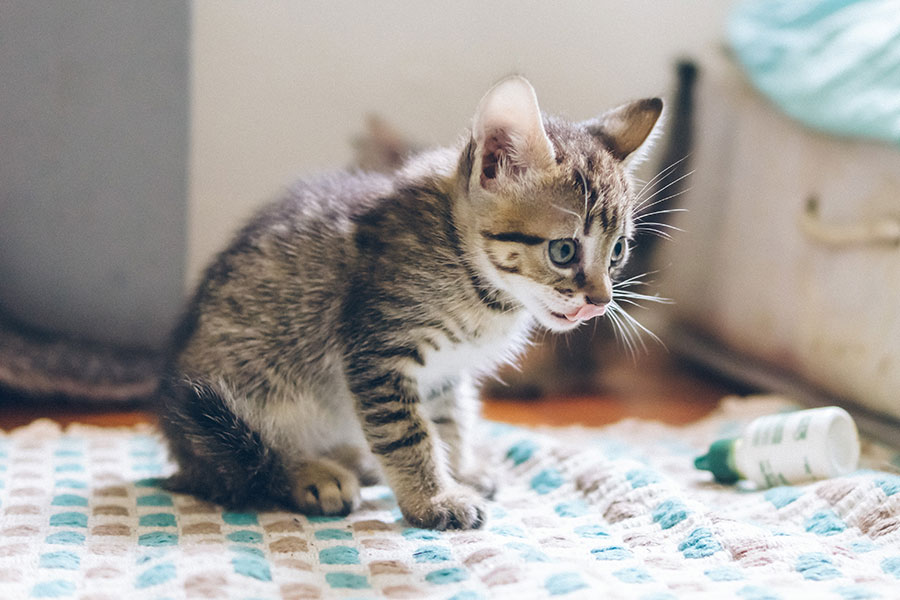
Vaccines in Cats: FVRCP
The Feline Viral Rhinotracheitis, Calicivirus, and Panleukopenia (FVRCP) vaccine series, also called the cat distemper vaccine, should be started at 6 to 8 weeks of age. This is boostered every 3 to 4 weeks until your kitten is 16 weeks old. This vaccine is also available in a 3-year version that can be given the year after your kitten’s initial vaccine series.
Feline panleukopenia is similar to parvovirus in dogs. It is a very contagious and life-threatening infectious disease that can spread among cat colonies or cats housed with many other cats. An infected cat sheds the virus via secretions, e.g., feces, vomit, urine, saliva, and mucus membranes. Infection occurs when the virus enters through the nose or mouth.
The virus suppresses the immune system and depletes the cat’s white blood cells, leaving the infected individual immunosuppressed and vulnerable to other infectious diseases. Clinical signs can be nonspecific and include fever, vomiting, diarrhea, and lethargy.
Similar to parvovirus in dogs, treatment of a cat infected with panleukopenia consists of hospitalization, aggressive fluids therapy, antinausea and anti diarrheal medications, and supportive care.
Vaccines in Cats: Feline Leukemia Virus
If your cat is an indoor/outdoor cat, the feline leukemia vaccine is highly recommended due to socialization with other cats. This vaccine requires an additional booster 3 to 4 weeks after initial dose.
Feline leukemia virus (FLV) is spread through close social contact with saliva, blood, urine, or feces. There is no effective treatment, so treatment consists of supportive care. Prognosis after infection can be variable.
One Last Reminder
Vaccinating your dogs and cats is very important. If your pet is not up to date on vaccines or their annual wellness exam, please schedule an appointment with their primary care veterinarian to get their vaccines updated.
And remember, prevention is cheaper than treatment.
—Dr. Angelica Calderon

Vacunas en Perros y Gatos
La prevención es más barata que el tratamiento. Una cita que siempre recordaré del Dr. Vinu, una veterinaria con la que trabajé durante mis estudios en la UIC.
Las vacunas son muy críticas en gatos y perros y sus series se inician a una edad muy temprana, incluso algunas vacunas necesitan ser reforzadas para que la mascota alcance la inmunidad adecuada. Hay muchas vacunas diferentes en gatos y perros. Algunas vacunas son vacunas básicas, lo que significa que se recomiendan para todos los pacientes, y otras se consideran vacunas de estilo de vida, lo que significa que depende de lo que haga su mascota. Su perro se aloja con frecuencia en un centro de alojamiento o va frecuentemente a la peluquería, donde puede estar rodeado de muchos otros perros? Su perro va a reservas forestales o a viajes de campamento donde puede estar expuesto a las garrapatas? Su gato es un gato estrictamente de interior o un gato de interior/exterior? Todas esas son excelentes preguntas que generalmente se hacen al comienzo de su examen anual de bienestar. Sí, es posible que le hagamos muchas preguntas durante el examen de bienestar de su mascota, pero estamos reuniendo las piezas del rompecabezas para recomendar el mejor programa de vacunas para su mascota.
Vacuna contra la Rabia en Perros y Gatos
La ley exige que su mascota sea vacunada contra la rabia. Se recomienda que la vacuna contra la rabia canina y felina se administre a los 4 meses de edad, sin embargo, a veces se puede administrar antes en un refugio. La primera vacuna suele ser una vacuna de 1 año, sin embargo, al año siguiente, su mascota puede recibir la vacuna contra la rabia de 1 año o de 3 años.
La rabia se transmite a través de heridas por mordedura, generalmente por la vida silvestre como zorrillos, murciélagos, mapaches y zorros. El virus se adhiere a las células musculares locales y luego penetra en los nervios locales y asciende al cerebro. No existe un tratamiento eficaz y fiable para la rabia y la infección suele provocar la muerte del animal. Una vez que los signos clínicos están presentes, la muerte puede ocurrir dentro de los 10 días. Si su mascota muerde a otro animal o humano y no está al día con la vacuna contra la rabia, dependiendo de su historial de vacunas, es posible que deba ser confinado y observado en un centro veterinario durante 10 días. Si el animal muestra algún síntoma o se sospecha que la mascota pueda tener rabia, se debe enviar su tejido cerebral para la toma de muestras. Esto significa que deben ser sacrificados humanamente para la presentación de tejido. Las regulaciones pueden variar según el estado o el condado, por lo que es importante mantenerse al día con las regulaciones actuales. Puede visitar rabiesaware.org para obtener más información sobre las regulaciones en su área. En última instancia, la prevención consiste en vacunar y limitar la exposición a la vida silvestre. Visite a su veterinario local si su mascota no está al día con la vacuna contra la rabia.
Vacunas en Perros
Distemper (DAPP):
La segunda vacuna básica en perros es la vacuna contra el distemper(DAPP). Esta vacuna protege contra los virus de distemper, el parvovirus, el adenovirus 1 y 2 y el virus de la parainfluenza. La vacuna DAPP se inicia a las 8 semanas de edad y debe reforzarse al menos 3 veces, con 3-4 semanas de diferencia. Esto significa que su cachorro recibirá la vacuna DAPP a las 8, 12 y 16 semanas de edad. Después de la serie inicial de cachorros, se vuelve anual. Esta vacuna también está disponible en un año 3 que se puede administrar el año siguiente después de la serie inicial de vacunas de sus cachorros.
El parvovirus es uno de los virus más comunes que cubre esta vacuna. Cualquier cachorro con signos clínicos que consisten en vómitos y diarrea debe someterse a una prueba de parvovirus y se puede llegar a un diagnóstico con una muestra fecal. Se necesitan cuidados intensivos para tratar a un perro que ha sido infectado con parvovirus y, en última instancia, el tratamiento es de apoyo. La atención de apoyo consiste en hospitalización, terapia de fluidos, antibióticos, medicamentos contra las náuseas, medicamentos contra la diarrea y el control de los cambios en los análisis de sangre (en particular, los glóbulos blancos de su perro). Esté preparado para una hospitalización de 5 a 7 días, así como para una factura costosa, según la gravedad de los síntomas de su perro. Sin tratamiento, este virus puede ser fatal. La prevención es más barata que el tratamiento.
Leptospirosis:
Aunque la vacuna contra la leptospirosis canina no es una vacuna básica, es muy recomendable en áreas que tienen una alta población de roedores. Puede administrarse tan pronto como a las 12 semanas de edad y debe reforzarse 3 o 4 semanas después de administrar la dosis inicial. Después de eso, se da anualmente.
Los perros pueden infectarse con esta bacteria a través de heridas abiertas o membranas mucosas que entran en contacto con orina infectada o agua o tierra infectada. Esta bacteria puede sobrevivir durante semanas o meses en el medio ambiente, por lo que es importante vacunar a su mascota si vive en un área con una gran población de roedores. La leptospirosis es zoonótica, lo que significa que los humanos también pueden infectarse. Esto puede conducir rápidamente a daños en los órganos y puede afectar los riñones y el hígado. Los signos clínicos pueden ser muy inespecíficos y el tratamiento consiste en antibióticos y atención de apoyo; sin embargo, en casos graves, puede provocar daños irreversibles en los órganos.
Bordetella:
La vacuna canina Bordetella cubre la tos canina. No requiere refuerzo y se administra anualmente, sin embargo en algunos casos se recomienda administrar cada 6 meses. Hay dos formas disponibles, por vía intranasal y por vía subcutánea.
Bordetella es esencialmente una bronquitis infecciosa y se transmite dentro de las secreciones respiratorias de un perro infectado. En situaciones de hacinamiento donde hay muchos animales en una instalación, por ejemplo, alojamiento o aseo, los perros pueden estar más predispuestos a la infección debido al contacto cercano y a la mala ventilación. Los signos clínicos pueden variar desde síntomas leves a graves, como tos seca, hasta neumonía. El tratamiento consiste en antibióticos y cuarentena durante el tratamiento. Tenga en cuenta que muchas instalaciones de alojamiento y aseo requiere esta vacuna.
Virus de la influenza canina (CIV):
La vacuna contra el virus de la influenza canina requiere un refuerzo adicional administrado de 3 a 4 semanas después de la primera dosis inicial, luego de lo cual se vuelve anual. Se puede iniciar desde las 16 semanas de edad.
Los signos clínicos pueden ser muy similares a los de Bordetella y pueden incluir tos, estornudos y secreción nasal. Los brotes se asocian más comúnmente con perreras donde los perros están en contacto cercano con otros perros y este virus se transmite a través de las secreciones nasales. Puede ser difícil distinguir Bordetella de CIV, por lo que el tratamiento consiste en controlar los signos secundarios y tratar sintomáticamente. Eso significa antibióticos y supresores de la tos, según la gravedad.
Lyme:
La vacuna canina de Lyme es una vacuna de estilo de vida. Esto significa que si tu perro va con frecuencia a reservas forestales o a acampar, o si vives en una zona muy boscosa, es muy recomendable debido a la exposición a las garrapatas. Se puede administrar en cualquier momento después de las 16 semanas de edad y requiere un refuerzo adicional de 3 a 4 semanas después de la primera dosis inicial. Después de eso, es una vacuna anual.
La enfermedad de Lyme se transmite a través de una picadura de garrapatas infectadas. La enfermedad de Lyme se puede diagnosticar con una prueba de gusano del corazón SNAP 4DX, que implica una muestra de sangre para su perro. Los resultados se obtienen en no más de 7-8 minutos. Sin embargo, incluso si su perro tiene un resultado positivo de Lyme, eso no diferencia la exposición frente a la infección activa. Los signos clínicos pueden variar y pueden ser muy inespecíficos. Estos pueden incluir fiebre, fatiga, articulaciones inflamadas, etc. El tratamiento consiste en antibióticos y el control de los síntomas secundarios. No olvide los preventivos mensuales contra pulgas y garrapatas de sus perros, ya que pueden reducir en gran medida la posibilidad de infección con la enfermedad de Lyme.
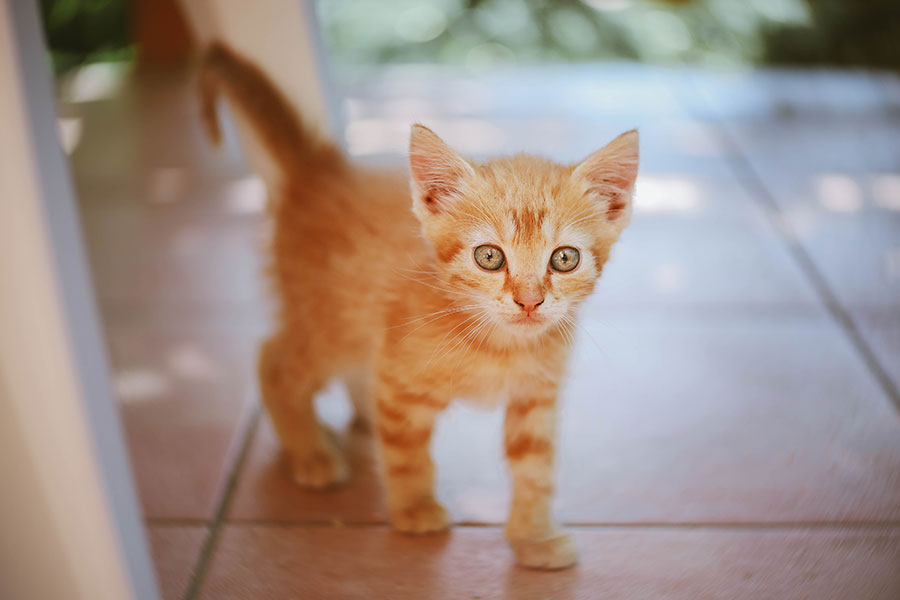
Vacunas en Gatos
FVRCP:
La serie de vacunas FVRCP (moquillo felino) debe comenzar a las 6-8 semanas de edad. Esta vacuna requiere refuerzos y se refuerza cada 3-4 semanas hasta que tu gatito tenga 16 semanas. Esta vacuna también está disponible en un año 3 que se puede administrar el año siguiente después de la serie inicial de vacunas de sus gatitos.
FVRCP significa rinotraqueítis viral felina, calicivirus y panleucopenia. La panleucopenia felina es similar al parvovirus en perros. Esta es una enfermedad infecciosa muy contagiosa y potencialmente mortal que puede afectar a las colonias de gatos o a los gatos alojados con muchos otros gatos si una persona está infectada. Un gato infectado elimina el virus a través de secreciones, que incluyen heces, vómito, orina, saliva y membranas mucosas. La infección se produce cuando el virus entra por la nariz o la boca. El virus suprime el sistema inmunológico y agota los glóbulos blancos del gato, dejando al individuo infectado inmunosuprimido y vulnerable a otras enfermedades infecciosas. Los signos clínicos pueden ser inespecíficos e incluyen fiebre, vómitos, diarrea y letargo. Similar al parvovirus en perros, el tratamiento de un gato infectado con panleucopenia consiste en hospitalización, fluidoterapia agresiva, así como antináuseas, antidiarreicas y atención de apoyo.
Virus de la leucemia felina
Si su gato es un gato de interior/exterior, la vacuna contra la leucemia felina es muy recomendable debido a la socialización con otros gatos. Esta vacuna requiere un refuerzo adicional de 3 a 4 semanas después de la dosis inicial.
FeLV (virus de la leucemia felina) se propaga a través del contacto social cercano con saliva, sangre, orina, heces. No existe un tratamiento eficaz, por lo que el tratamiento consiste en cuidados de apoyo. El pronóstico después de la infección puede ser variable.
Es muy importante vacunar a sus perros y gatos. Si su mascota no está al día con las vacunas o su examen anual de bienestar, programe una cita con su veterinario de atención primaria para actualizar sus vacunas.
Y recuerda, la prevención es más barata que el tratamiento.
—Dr. Angelica Calderon
Hyperthyroidism in Cats: Is This Why Your Older Cat Is Skinny?
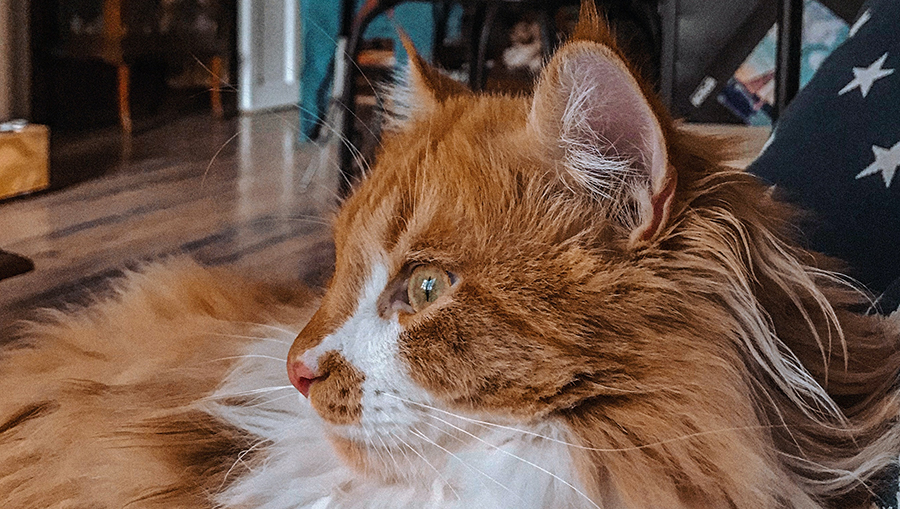
Hyperthyroidism is the most common endocrine disease in middle-aged and senior cats. It is typically diagnosed when the cat is 12 to 13 years old.
Like the name implies, hyperthyroidism is the increased production and secretion of thyroid hormones from an abnormally functioning and enlarged thyroid gland. Because thyroid hormones affect almost every organ in a cat’s body, having excessive hormones typically causes secondary health issues, such as heart disease and high blood pressure. Hyperthyroidism can also mask kidney disease in cats.
In most cases, this disease is caused by a non-cancerous tumor, called an adenoma, on the thyroid gland. The exact cause of this disease in cats is not currently known.
Clinical Signs and Diagnosis
The most common sign of hyperthyroidism is weight loss in the face of an increased appetite. Over time, a cat with hyperthyroidism will become increasingly skinnier and may also lose muscle mass.
These cats may also experience increased thirst and urination, changes to their hair coat quality (more greasy, matted, or unkempt), vomiting, diarrhea, and increased vocalization.
Diagnosis of hyperthyroidism is through a complete physical examination as well as lab testing (complete blood count, chemistry, urinalysis, and thyroid hormones). If cat has hyperthyroidism, a thyroid hormone called T4 will be elevated on these lab tests.
Treatment
There are currently four methods of treatment for hyperthyroidism; all have the goal of returning thyroid hormone levels to normal. Treatment options include medical therapy with antithyroid drugs; dietary therapy with iodine-restricted diets; surgical removal of the thyroid gland; and radioactive iodine therapy.
Medical Therapy
Methimazole is the most common anti-thyroid medication. It reduces the production and release of thyroid hormone from the thyroid gland. This therapy does not serve as a cure for the disease but allows for control.
Methimazole is relatively inexpensive and is either administered orally or as a transdermal gel that is applied to the ear. Both forms of medication are given twice a day. Some cats experience side effects of this medication within the first few months of starting it. These include vomiting, decreased appetite, lethargy, and skin itchiness that causes the cat to scratch and wound their face.
While on methimazole, repeated blood monitoring must be done to ensure the proper dosage is being used as well as to monitor kidney function and overall health. During the first 2 to 3 months of treatment, lab testing is done every 2 to 3 weeks. After thyroid hormone levels have normalized, monitoring is then done every 3 to 6 months.
Dietary Therapy
Feeding an iodine-restricted diet is another therapeutic option. This approach works because iodine is needed for the body to produce thyroid hormones. For the best results, this diet must be fed exclusively and consistently. These diets have been shown to reduce the levels of thyroid hormones in 3 to 4 weeks. If normal thyroid hormone levels are not achieved within 12 weeks, a different form of treatment is usually selected. Dietary therapy is not effective if the cat does not like to eat the food or regularly has access to other forms of food.
Surgery
Removal of the thyroid glands is another form of treatment. It is a straightforward procedure for a skilled surgeon and has a good success rate. Surgery has the advantage of being curative and eliminating the need for long-term medication administration. A risk of surgery is accidental damage to the parathyroid glands, which are located close to the thyroid glands. If the parathyroid glands are damaged, the cat’s body will have difficulty producing calcium. Because less invasive treatment options are available, surgery is rarely selected for treatment.
Radioactive Iodine Therapy
Radioactive iodine therapy is currently considered the treatment of choice for cats with hyperthyroidism. Radioactive iodine is given as an injection, which then travels through the bloodstream to the thyroid gland. The radiation from the radioactive iodine then destroys the abnormal thyroid tissue without damaging the surrounding healthy tissue.
The radioactivity does not harm the cat but does pose a risk for humans. Due to this, cats undergoing this treatment are hospitalized for 3 to 5 days after treatment until the radiation levels are low. Cats are not allowed visitors during this time. In 95% of cases, this treatment is curative within 3 months. If not successful, the treatment can be repeated. In rare cases, a cat can become hypothyroid (producing too low levels of thyroid hormone), which then must be treated with thyroid hormone supplement.
Prognosis
Once hyperthyroidism is diagnosed and a form of treatment is selected, most cats do well. As medical therapy and dietary therapy are not curative, treatment is lifelong in these cases. Surgery and radioactive iodine therapy are considered curative, so lifelong treatment is not needed.
If your cat is experiencing any of the clinical signs mentioned, please reach out to your veterinarian to have your cat tested. If your cat is diagnosed with hyperthyroidism, you and your veterinarian can determine the best treatment option for your cat.
—Jeanette Barragan, DVM
Featured photo by Ekaterina Zagorska on Unsplash
